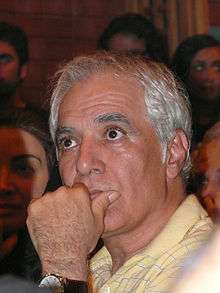Mahmoud Kalari
| Mahmoud Kalari محمود کلاری | |
|---|---|
 | |
| Born |
April 31, 1951 Tehran, Iran |
| Occupation | Director of Photography, Screenwriter, Film Director, Photographer |
Mahmoud Kalari, (Persian: محمود کلاری; born April 31, 1951) in Tehran, is an Iranian cinematographer, screenwriter, film director and photographer, who has worked with most of renown Iranian directors such as Abbas Kiarostami, Jafar Panahi, Asghar Farhadi and Mohsen Makhmalbaf in their award-winning works.
After completing photography courses in the United States, he held his first photo exhibition titled "Visit with People Around Us" at Tehran University in 1976. A few years later he became employed by Paris-based Sigma Photo News Agency and worked for them for four years. In 1980 he was ranked one of the '15 Best Photographers of the Year' by Time Magazine, and his photos could be seen in French, German, and American magazines. Kalari moved back to Iran and from 1982 to 1984 worked as the supervisor of the Tehran National TV Photography Unit and taught photojournalism at Tehran University as a guest professor.
Kalari started his film career in 1984 as the cinematographer of Jadehay sard[1] (1985) (Frosty Roads) for which he won the Best Cinematography award at Tehran's Fajr International Film Festival. He has shot more than 65 films since then including some of the most critically acclaimed and talked about movies in Iran and internationally. To mention a few: Sorb (1988) (winner of the best cinematography), Reyhaneh (1995) (screened at San Sebastián International Film Festival), Nobat e Asheghi (1990) (filmed in Turkey and screened at Cannes Film Festival), "From Karkheh to Rein" (1990) (filmed in Germany and screened at Hamburg and Mannheim Film Festivals), Sara (1992) (screened at San Sebastian, New York, Los Angeles, and Chicago Film Festivals) Salaam Cinema (1995) (screened at Montreal, Toronto, Los Angeles, New York, and Cannes Film Festivals) Gabbeh (1996) (screened at Cannes, Montreal, Toronto, Vancouver, New York, Los Angeles and 21 other International Film Festivals around the world, winner of Best Cinematography at Fajr International Film Festival and winner of Fujifilm Motion Picture Award), Leila (1997) (screened at 7 international film festivals and the winner of the best cinematography at Fajr Film Festival), Derakhte Golabi (1998) (winner of Silver Hugo at Chicago Film Festival and chosen as the Best Motion Picture Photography by the international jury of the Fajr Film Festival), Bad ma ra khahad bord (1999) for which Kalari received nominations for Best Cinematography in the Main Competition of Plus CAMEIMAGE International Film Festival of the Art of Cinematography, and Offside (2006) (screened at Berlin, New York, and AFI Film Festivals).
Kalari directorial debut is Abr-O Aftaab (1997) on which he was also the writer and cinematographer. It was screened at Montreal and Chicago Film Festivals and won the Best Film award at Argentina Mardel Plata Film Festival.[2]
Kalari was selected as a Jury Panelist for Poland Film Festival both in 1999 and 2000. In 2001, Nant Festival in Paris held a tribute to his work as a photographer and exhibited his photographs. In 2005 he won the best cinematography award for Bab'Aziz (2005), directed by Tunisian-French director Nacer Khemir, from the Tatarstan International Muslim Film Festival. Later, a gallery of his photos shot during the Iranian Revolution of 1979 was opened to the public, and a photo book of his work from that era was published. Kalari's work on the internationally critically acclaimed and Oscar winner film, Jodaeiye Nader az Simin (A Separation) (2011), earned him a Silver Frog from Plus CAMERIMAGE International Film Festival of the Art of Cinematography in 2011.
He has brought the vision of many great Iranian directors to life, such as Masud Kimiai, Ali Hatami, Dariush Mehrjui, Mohsen Makhmalbaf, Tahmineh Milani, Palme d'Or winner Abbas Kiarostami, Oscar nominee Majid Majidi, and Oscar winner Asghar Farhadi. Kalari has had workshops in different cities of Iran and teaches cinematography as he continues to shoot.
References
- ↑ http://www.imdb.com/title/tt0091086
- ↑ "14º Festival". Mar del Plata International Film Festival. Retrieved 6 January 2016.